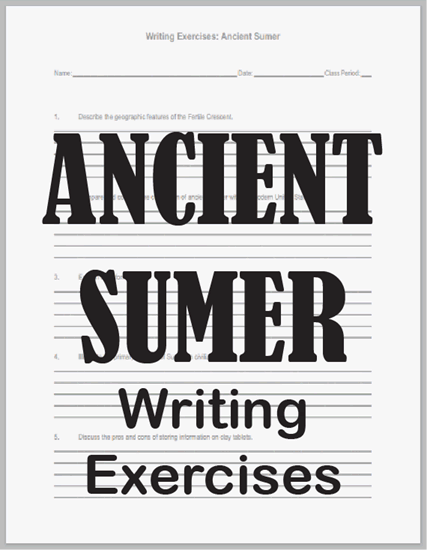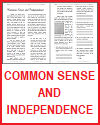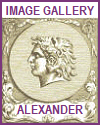| Ancient Sumer Writing Exercises |
|---|
| www.studenthandouts.com ↣ World History ↣ Ancient Near East ↣ Ancient Near East Worksheets |
 |
    |
|
1. Describe the geographic features of the Fertile Crescent.
The Fertile Crescent is a crescent-shaped region in the Middle East known for its rich soil and early agricultural development. It stretches from the Persian Gulf through modern-day Iraq, Syria, and Lebanon to Egypt. Bounded by the Tigris and Euphrates Rivers, it offered water for farming and supported the rise of ancient civilizations. Its geography fostered trade, settlement, and innovation. 2. Compare and contrast the civilization of ancient Sumer with the modern United States. Ancient Sumer and the modern United States differ greatly in technology, government, and society. Sumer had city-states ruled by kings and priests, while the U.S. is a democratic republic. Sumerians practiced polytheism and wrote in cuneiform, while the U.S. is religiously diverse and uses modern alphabets. Both societies, however, value written laws and innovation, and developed complex urban centers. 3. Explain cuneiform writing. Cuneiform was one of the world's earliest writing systems, developed by the Sumerians around 3200 B.C.E. It involved pressing a stylus into soft clay tablets to create wedge-shaped marks. Originally used for record-keeping, it later expanded to include laws, literature, and administrative documents. Cuneiform enabled communication, governance, and the preservation of knowledge in ancient Mesopotamia. 4. Illustrate the primary features of Sumerian civilization. Sumerian civilization, located in southern Mesopotamia, featured city-states like Ur and Uruk, each with its own ruler and deity. It developed cuneiform writing, built ziggurats as religious centers, and relied on irrigation farming. Sumerians created a complex social hierarchy, practiced polytheism, and made advances in math, astronomy, and law, laying foundations for future civilizations. 5. Discuss the pros and cons of storing information on clay tablets. Storing information on clay tablets had advantages, such as durability and resistance to decay, making them excellent for preserving records over time. They also allowed for standardized writing, like cuneiform. However, tablets were heavy, fragile when dry, and difficult to transport or store in large quantities. Their limited surface area also made recording lengthy texts challenging. Click here to print (PDF file). Answers will vary. |
| Ancient Near East Books and Films | Ancient Near East Outlines and PowerPoints |
| Ancient Near East Maps and Pictures | Ancient Near East Study Games |
| Ancient Near East Miscellany | Ancient Near East Worksheets |
| www.studenthandouts.com ↣ World History ↣ Ancient Near East ↣ Ancient Near East Worksheets |








